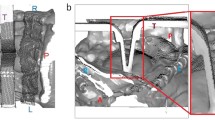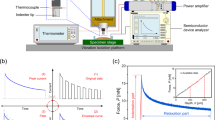Abstract
Corresponding to pre-puncture and post-puncture insertion, elastic and viscoelastic mechanical properties of brain tissues on the implanting trajectory of sub-thalamic nucleus stimulation are investigated, respectively. Elastic mechanical properties in pre-puncture are investigated through pre-puncture needle insertion experiments using whole porcine brains. A linear polynomial and a second order polynomial are fitted to the average insertion force in pre-puncture. The Young’s modulus in pre-puncture is calculated from the slope of the two fittings. Viscoelastic mechanical properties of brain tissues in post-puncture insertion are investigated through indentation stress relaxation tests for six interested regions along a planned trajectory. A linear viscoelastic model with a Prony series approximation is fitted to the average load trace of each region using Boltzmann hereditary integral. Shear relaxation moduli of each region are calculated using the parameters of the Prony series approximation. The results show that, in pre-puncture insertion, needle force almost increases linearly with needle displacement. Both fitting lines can perfectly fit the average insertion force. The Young’s moduli calculated from the slope of the two fittings are worthy of trust to model linearly or nonlinearly instantaneous elastic responses of brain tissues, respectively. In post-puncture insertion, both region and time significantly affect the viscoelastic behaviors. Six tested regions can be classified into three categories in stiffness. Shear relaxation moduli decay dramatically in short time scales but equilibrium is never truly achieved. The regional and temporal viscoelastic mechanical properties in post-puncture insertion are valuable for guiding probe insertion into each region on the implanting trajectory.







Similar content being viewed by others
References
Foltynie T, Zrinzo L, Martinez-Torres I, Tripoliti E, Petersen E, Holl E, Aviles-Olmos I, Jahanshahi M, Hariz M, Limousin P. MRI-guided STN DBS in Parkinson’s disease without microelectrode recording: efficacy and safety. J Neurol Neurosurg Psychiatry. 2011;82(4):358–63.
Shin M, Lefaucheur JP, Penholate MF, Brugieres P, Gurruchaga JM, Nguyen JP. Subthalamic nucleus stimulation in Parkinson’s disease: postoperative CT-MRI fusion images confirm accuracy of electrode placement using intraoperative multi-unit recording. Neurophysiol Clin. 2007;37(6):457–66.
Benazzouz A, Breit S, Koudsie A, Pollak P, Krack P, Benabid AL. Intraoperative microrecordings of the subthalamic nucleus in Parkinson’s disease. Mov Disord. 2002;17(Suppl. 3):S145–49.
Machado A, Rezai AR, Kopell BH, Gross RE, Sharan AD, Benabid AL. Deep brain stimulation for Parkinson’s disease: surgical technique and perioperative management. Mov Disord. 2006;21(Suppl.14):S247–58.
Obuchi T, Katayama Y, Kobayashi K, Oshima H, Fukaya C, Yamamoto T. Direction and Predictive factors for the shift of brain structure during deep brain stimulation electrode implantation for advanced Parkinson’s disease. Neuromodulation. 2008;11(4):302–10.
Bejjani BP, Dormont D, Pidoux B, Yelnik J, Damier P, Arnulf I, Bonnet AM, Marsault C, Agid Y, Philippon J, Cornu P. Bilateral subthalamic stimulation for Parkinson’s disease by using three-dimensional stereotactic magnetic resonance imaging and electrophysiological guidance. J Neurosurg. 2000;92(4):615–25.
Polikov VS, Tresco PA, Reichert WM. Response of brain tissue to chronically implanted neural electrodes. J Neurosci Methods. 2005;148(1):1–18.
Welkenhuysen M, Andrei A, Ameye L, Eberle W, Nuttin B. Effect of insertion speed on tissue response and insertion mechanics of a chronically implanted silicon-based neural probe. IEEE Trans Biomed Eng. 2011;58(11):3250–9.
Casanova F, Carney PR, Sarntinoranont M. In vivo evaluation of needle force and friction stress during insertion at varying insertion speed into the brain. J Neurosci Methods. 2014;237:79–89.
Jensen W, Yoshida K, Hofmann UG. In-vivo implant mechanics of flexible, silicon-based ACREO microelectrode arrays in rat cerebral cortex. IEEE Trans Biomed Eng. 2006;53(5):934–40.
Fekete Z, Nemeth A, Marton G, Ulbert I, Pongracz A. Experimental study on the mechanical interaction between silicon neural microprobes and rat dura mater during insertion. J Mater Sci: Mater Med. 2015;26:70
Miller K. How to test very soft biological tissues in extension? J Biomech. 2001;34(5):651–7.
Miller K, Chinzei K, Orssengo G, Bednarz P. Mechanical properties of brain tissue in-vivo: experiment and computer simulation. J Biomech. 2000;33(11):1369–76.
Balachandran R, Welch EB, Dawant BM, Fitzpatrick JM. Effect of MR Distortion on Targeting for Deep-Brain Stimulation. IEEE Trans Biomed Eng. 2010;57(7):1729–35.
Fiegele T, Feuchtner G, Sohm F, Bauer R, Anton JV, Gotwald T, Twerdy K, Eisner W. Accuracy of stereotactic electrode placement in deep brain stimulation by intraoperative computed tomography. Parkinsonism Relat Disord. 2008;14(8):595–9.
Finan JD, Elkin BS, Pearson EM, Kalbian IL, Morrison B 3rd. Viscoelastic properties of the rat brain in the sagittal plane: effects of anatomical structure and age. Ann Biomed Eng. 2012;40(1):70–8.
Soza G, Grosso R, Nimsky C, Hastreiter P, Fahlbusch R, Greiner G. Determination of the elasticity parameters of brain tissue with combined simulation and registration. Int J Med Robot. 2005;1(3):87–95.
Subbaroyan J, Martin DC, Kipke DR. A finite-element model of the mechanical effects of implantable microelectrodes in the cerebral cortex. J Neural Eng. 2005;2(4):103–13.
Gefen A, Gefen N, Zhu QL, Raghupathi R, Margulies SS. Age-dependent changes in material properties of the brain and braincase of the rat. J Neurotrauma. 2003;20(11):1163–77.
Elkin BS, Ilankova A, Morrison B 3rd. Dynamic, regional mechanical properties of the porcine brain: indentation in the coronal plane. J Biomech Eng. 2011;133(7):071009
Prevost TP, Balakrishnan A, Suresh S, Socrate S. Biomechanics of brain tissue. Acta Biomater. 2011;7(1):83–95.
Elkin BS, Ilankovan AI, Morrison B 3rd. A detailed viscoelastic characterization of the P17 and adult rat brain. J Neurotrauma. 2011;28:2235-44.
Miller K. Constitutive model of brain tissue suitable for finite element analysis of surgical procedures. J Biomech. 1999;32(5):531–7.
Dommelen JAW, Sande TPJ, Hrapko M, Peters GWM. Mechanical properties of brain tissue by indentation: interregional variation. J Mech Behav Biomed Mater. 2010;3(2):158–66.
Prange MT, Margulies SS. Regional, directional, and age-dependent properties of the brain undergoing large deformation. J Biomech Eng. 2002;124(2):244–52.
Miller K, Chinzei K. Mechanical properties of brain tissue in tension. J Biomech. 2002;35(4):483–90.
Pervin F, Chen WW. Dynamic mechanical response of bovine gray matter and white matter brain tissues under compression. J Biomech. 2009;42(6):731–5.
Prevost TP, Jin G, Moya MA, Alam HB, Suresh S, Socrate S. Dynamic mechanical response of brain tissue in indentation in vivo, in situ and in vitro. Acta Biomater. 2011;7(12):4090–101.
Abolhassani N, Patel R, Moallem M. Needle insertion into soft tissue: a survey. Med Eng Phys. 2007;29(4):413–31.
Okamura AM, Simone C, O’Leary MD. Force modeling for needle insertion into soft tissue. IEEE Trans Biomed Eng. 2004;51(10):1707–16.
Prange MT, Meaney DF, Margulies SS. Defining brain mechanical properties: effects of region, direction, and species. Stapp Car Crash J. 2000;44:205–13.
Nicolle S, Lounis M, Willinger R. Shear properties of brain tissue over a frequency range relevant for automotive impact situations: new experimental results. Stapp Car Crash J. 2004;48:239-58.
D’Haese PF, Pallavaram S, Niermann K, Spooner J, Kao C, Konrad PE, Dawant BM. Automatic selection of DBS target points using multiple electrophysiological atlases. Med Image Comput Comput Assist Interv. 2005;8(Pt 2):427–34.
Garo A, Hrapko M, Dommelen JAW, Peters GWM. Towards a reliable characterisation of the mechanical behaviour of brain tissue: the effects of post-mortem time and sample preparation. Biorheology. 2007;44(1):51–8.
Sharp AA, Ortega AM, Restrepo D, Curran-Everett D, Gall K. In vivo penetration mechanics and mechanical properties of mouse brain tissue at micrometer scales. IEEE Trans Biomed Eng. 2009;56(1):45–53.
Zhang M, Zheng YP, Mak AFT. Estimating the effective Young’s modulus of soft tissues from indentation tests-nonlinear finite element analysis of effects of friction and large deformation. Med Eng Phys. 1997;19(6):512–7.
Fischer-Cripps AC. Introduction to Contact Mechanics. New York: Springer-Verelag; 2000.
Hayes WC, Keer LM, Herrmann G, Mockros LF. A mathematical analysis for indentation tests of articular cartilage. J Biomech. 1972;5(5):541–51.
Finan JD, Fox PM, Morrison B 3rd. Non-ideal effects in indentation testing of soft tissues. Biomech Model Mechanobiol. 2014;13(3):573–84.
Bonferroni CE. Il calcolo delle assicurazioni su gruppi diteste. Studi in onore del Professore Salvatore Ortu Carboni. 1935; 13–60.
Walsh EK, Furniss WW, Schettini A. On measurement of brain elastic response in vivo. Am J Physiol Regul Integr Comp Physiol. 1977;232(1):R27-R30.
Kobayashi Y, Sato T, Fujie MG. Modeling of friction force based on relative velocity between liver tissue and needle for needle insertion simulation. 31st Annual International Conference of the IEEE EMBS. 2009:5274-8.
Nagashima T, Shirakuni T, Rapoport SI. A two-dimensional, finite element analysis of vasogenic brain edema. Nerol. Med. Chir. 1990;30:1-9.
Lee H, Bellamkonda RV, Sun W, Levenston ME. Biomechanical analysis of silicon microelectrode-induced strain in the brain. J Neural Eng. 2005;2(4):81–9.
DiMaio SP, Salcudean SE. Needle insertion modeling and simulation. IEEE trans Robot Automation. 2003;19(5):864–75.
Andrei A, Welkenhuysen M, Nuttin B, Eberle W. A response surface model predicting the in vivo insertion behavior of micromachined neural implants. J Neural Eng. 2012;9:016005
Acknowledgments
This work is supported by the National Science Foundation of China (Grant No. 51375268) and Independent Innovation Foundation of Shandong University (Grant No. 2012ZD009). Thanks for the help of the experienced neurosurgeon in Qilu hospital.
Author information
Authors and Affiliations
Corresponding authors
Ethics declarations
Conflict of interest
The authors declare that they have no conflict of interest.
Rights and permissions
About this article
Cite this article
Li, Y., Deng, J., Zhou, J. et al. Elastic and viscoelastic mechanical properties of brain tissues on the implanting trajectory of sub-thalamic nucleus stimulation. J Mater Sci: Mater Med 27, 163 (2016). https://doi.org/10.1007/s10856-016-5775-5
Received:
Accepted:
Published:
DOI: https://doi.org/10.1007/s10856-016-5775-5




